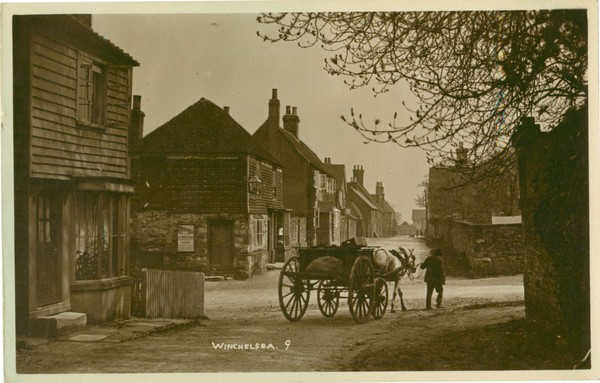Frederick James Parsons (F. J. Parsons Ltd.)

Mill Lane, Winchelsea, looking east, near the junction with Hiham Green
Newspaper proprietor with premises at 14 Claremont, Hastings, and also at Devonshire Road, Bexhill, and at Folkestone. Isaac Parsons of Rye founded the Rye Chronicle in 1853 and in 1866 his son, Frederick James Parsons (1844-1900), bought the fledgling Hastings Observer, which later became the Hastings and St Leonards Observer (see Steve Peak, The Hastings papers- a history of the Hastings and St Leonards newspapers, 2007, SpeaksBooks, Hastings). By dint of hard work and helped by a dedicated editor, Frederick was able to build up the circulation of the Hastings paper and move production to a large new printworks at Claremont. His company, F.J. Parsons Ltd., remained the publishers and proprietors of the Hastings and St Leonards Observer until 1971. In its heyday just after the First World War, F.J. Parsons Ltd. printed local newspapers for all the towns along the south coast from Bexhill to Folkestone, as well as an impressive array of magazines and journals. It also printed Electoral Registers for much if not all of Sussex.
During the early 1900s Hastings experienced a sharp decline in prosperity as the wealthy began to leave the town in increasing numbers and unemployment rose. Despite this, F.J. Parsons Ltd. were able to expand and diversify their operations. By August 1906 they were selling black and white collotype cards of Bexhill with red captions, labelled "F. J. Parsons Ltd. Bexhill-on-Sea" and by 1910 they were offering their services to the public as photographers. Their sepia-toned (less commonly black and white) real photographic cards of Hastings and Bexhill first went on sale in about 1912, and production continued until just after the First World War. Some of the pictures on these real photographics may have first appeared in the Hastings and St. Leonards Observer.
The real photographics are notable for their sharp focus and informal but satisfying composition. People in the pictures are not obviously posing yet rarely if ever look awkward or blurred. Where the cards have captions these are normally in capitals with the first capital of each word slightly enlarged. On the majority of cards the pictures have white borders, but some cards have pictures without borders.
One real photographic with a narrow, white border records the "visit of a tank to Hastings, July 15-16, 1913". Others show a military band at Hastings in 1914, crowds watching a procession, Hastings Pier on fire in 1917 (at least 6 cards), and the stranded ex-German submarine on Hastings beach in 1919. A card of the "New Band Stand and Parade Extension, Hastings" has a neatly printed caption in a white border below the photograph (see Gallery). The band stand was erected just before the First World War (or in 1916, accounts differ), but the card almost certainly dates from after the War.
A sepia card with a border shows the seafront at Bexhill, another bathers in the sea (1912 postmark). A third Bexhill card, of the Parish Church, has no border. A somewhat murky black and white aerial view shows Bexhill waterfront from a sea-plane. A June 1915 postmark proves that it was taken when flying was still very much in its infancy.
Parsons also produced a series of attractive sepia real photographic cards of Rye and Winchelsea.
To directory of publishersTo gallery
Design: Lucid Design
© www.sussexpostcards.info
